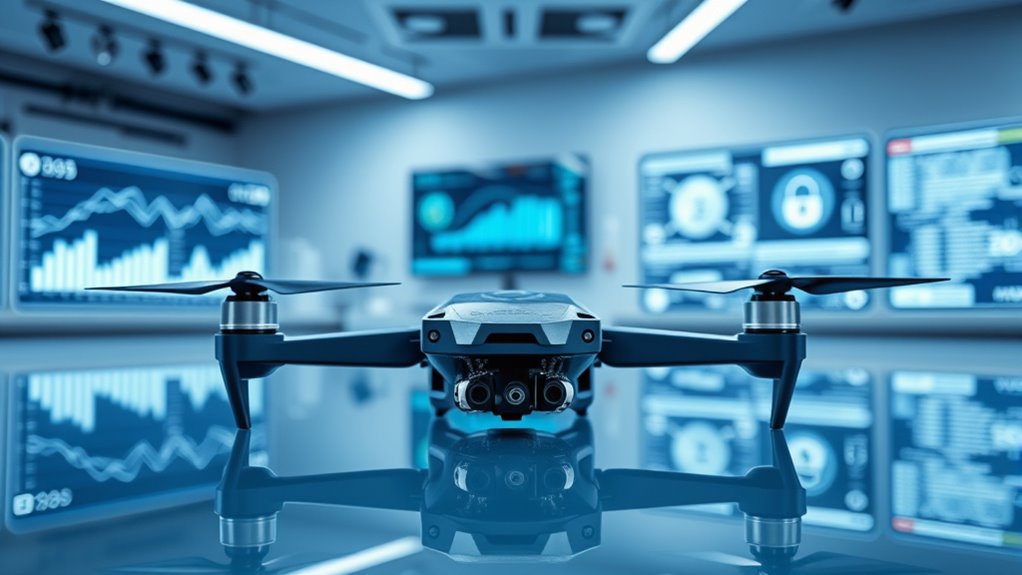Balancing innovation and security in dual-use technology involves understanding its benefits and risks. You need to contemplate ethical practices, responsible regulation, and international cooperation to prevent misuse while encouraging progress. Transparency and ongoing assessments help manage potential dangers, ensuring innovations serve society positively. It’s a complex challenge that requires collaboration among scientists, policymakers, and citizens. Exploring how ethical guidelines and regulatory frameworks can support this balance will give you a clearer picture of how to navigate this evolving landscape.
Key Takeaways
- Regulatory frameworks and policies guide responsible development while adapting to emerging dual-use risks.
- Ethical considerations and transparency are essential to prevent misuse of sensitive technologies.
- Balancing security concerns with innovation requires ongoing dialogue among scientists, policymakers, and the public.
- Oversight mechanisms, licensing, and export controls help mitigate proliferation and safeguard societal interests.
- Promoting cross-disciplinary collaboration fosters responsible innovation and aligns technological progress with security needs.

Dual-use technology refers to innovations that can be employed for both civilian and military purposes. As you navigate this complex landscape, one of the most pressing concerns is understanding the ethical implications involved. These technologies, while offering significant benefits like advancing healthcare, improving transportation, or boosting industrial productivity, also pose risks if misused or intentionally diverted for harmful purposes. For example, genetic editing tools like CRISPR can revolutionize medicine, but they also raise questions about bioethics and potential misuse in creating biological weapons. You must consider how the ethical dimension influences not just policy decisions but also the day-to-day development and deployment of such technologies. Balancing innovation with responsibility becomes a shared challenge, demanding transparency, accountability, and ongoing ethical assessments. Encouraging collaboration across disciplines can lead to more comprehensive approaches to managing these issues.
Understanding ethical implications is crucial for responsible development of dual-use technologies.
Alongside these ethical considerations, establishing effective regulatory frameworks is essential to manage dual-use technologies responsibly. You’re responsible for understanding how laws and policies can shape the trajectory of these innovations, ensuring they serve public interests without enabling malicious activities. Governments and international organizations endeavor to create guidelines that prevent the proliferation of sensitive technologies, such as military-grade encryption or advanced surveillance tools, while still fostering innovation. These frameworks often involve licensing systems, export controls, and oversight bodies that monitor research and commercial applications. You should recognize that regulations are not static; they evolve alongside technology, requiring constant updates and international cooperation to keep pace with rapid advancements. Implementing robust oversight mechanisms can help mitigate risks associated with technology proliferation.
However, implementing regulatory frameworks isn’t straightforward. It involves balancing security concerns with the need for scientific progress and economic growth. Overly restrictive rules might stifle innovation, while lax regulations could allow dangerous technologies to fall into the wrong hands. You play a role in supporting transparent dialogues among scientists, policymakers, and the public to develop policies that reflect shared values without hindering technological progress. Furthermore, you need to stay informed about emerging risks and ethical debates, as new dual-use applications continually challenge existing regulatory boundaries. Recognizing the importance of ethical frameworks can foster adaptive and responsible policy development. Emphasizing creative practice can cultivate innovative solutions for complex regulatory challenges, fostering adaptable and forward-thinking policies.
Ultimately, managing dual-use technology demands a nuanced approach—one that respects the ethical implications and enforces robust, adaptable regulatory frameworks. Your involvement, whether as a researcher, policymaker, or informed citizen, is essential to fostering an environment where innovation thrives responsibly. By understanding the delicate balance between advancing technology for societal benefit and safeguarding against its misuse, you contribute to shaping a future where progress and security go hand in hand.
Frequently Asked Questions
How Can Governments Effectively Regulate Dual-Use Technologies?
You can effectively regulate dual-use technologies by implementing thorough export controls that restrict sensitive items to trusted entities. Establishing robust security protocols ensures that these technologies don’t fall into the wrong hands. Regularly updating regulations to keep pace with technological advances and fostering international cooperation helps you balance innovation with security. By staying proactive and vigilant, you protect national interests while encouraging responsible technological development.
What Are the Ethical Considerations in Developing Dual-Use Innovations?
When developing dual-use innovations, you face ethical dilemmas and moral responsibilities that demand careful thought. You must consider how your technology could be misused or cause harm, balancing progress with potential risks. It’s vital to prioritize transparency, accountability, and safety, ensuring that your work benefits society without enabling malicious activities. By addressing these ethical considerations, you help foster responsible innovation that aligns with moral responsibilities and societal well-being.
How Do International Laws Address Dual-Use Technology Proliferation?
You’re on the right track thinking international laws try to keep a lid on dual-use tech. Treaties like the Wassenaar Arrangement set export controls to prevent proliferation, while other agreements foster cooperation. These laws aim to establish a balance—encouraging innovation without risking security. Though not perfect, they serve as a global framework, helping countries work together to manage risks and ensure that advancements don’t fall into the wrong hands.
What Role Do Private Companies Play in Dual-Use Technology Security?
You play a vital role in dual-use technology security through corporate responsibility and innovation oversight. By implementing strict controls, monitoring processes, and compliance measures, you help prevent proliferation risks. Your company must balance fostering innovation with safeguarding security, ensuring that dual-use technologies aren’t misused. Active oversight, transparent practices, and adherence to regulations enable you to contribute to global security while supporting technological advancements responsibly.
How Can Researchers Balance Innovation With Potential Misuse Risks?
Imagine walking a tightrope between innovation and safety. To balance this, you must employ rigorous research oversight, ensuring every discovery is scrutinized like a precious gem. Ethical frameworks serve as your guiding compass, helping you navigate potential misuse risks. By fostering transparency and accountability, you keep progress from becoming a double-edged sword, allowing innovation to flourish without releasing unintended harm.
Conclusion
Steering dual-use technology is like walking a tightrope—every innovation holds the potential to elevate or endanger us. You must balance progress with caution, recognizing that today’s breakthrough can become tomorrow’s threat. As you innovate, remember that with great power comes great responsibility. Embrace the promise of progress but remain vigilant, for in the shadows of advancement lies the fine line between salvation and peril—an ongoing dance between hope and harm.









